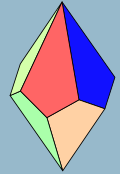热门问题
时间线
聊天
视角
五方偏方面体
来自维基百科,自由的百科全书
Remove ads
五方偏方面体是正十二面体的相对的两个面下面所接的棱延长交于一点所形成的多面体。[1][2]
性质
五方偏方面体共由10个面、20条边和12个顶点组成。组成五方偏方面体的10个面都是筝形,而组成五方偏方面体的12个顶点有2个是5个筝形的公共顶点,另外10个是3个筝形的公共顶点。[3]
十面体骰子

五方偏方面体有10个面,可用于游戏骰子,并于1906年获得专利。[4]由于这种骰子正好有10个面,因此经常应用于一些需要以百分位数计分的游戏。而正二十面体作为正多面体具有比五方偏方面体(非正多面体)更高的对称性,因此有时也会使用在正二十面体的20个面上标记2次0至9的数字代替五方偏方面体形状的骰子。
随后的十面骰子专利透过截去或圆滑化边缘对骰子的基本设计进行改善,其主要目的是增加骰子结果预测的难度。这个专利知名于1980年的Gen Con大会上[5],当时人们误认该专利涵盖了各种十面骰子。
相关多面体
参考文献
Wikiwand - on
Seamless Wikipedia browsing. On steroids.
Remove ads





















